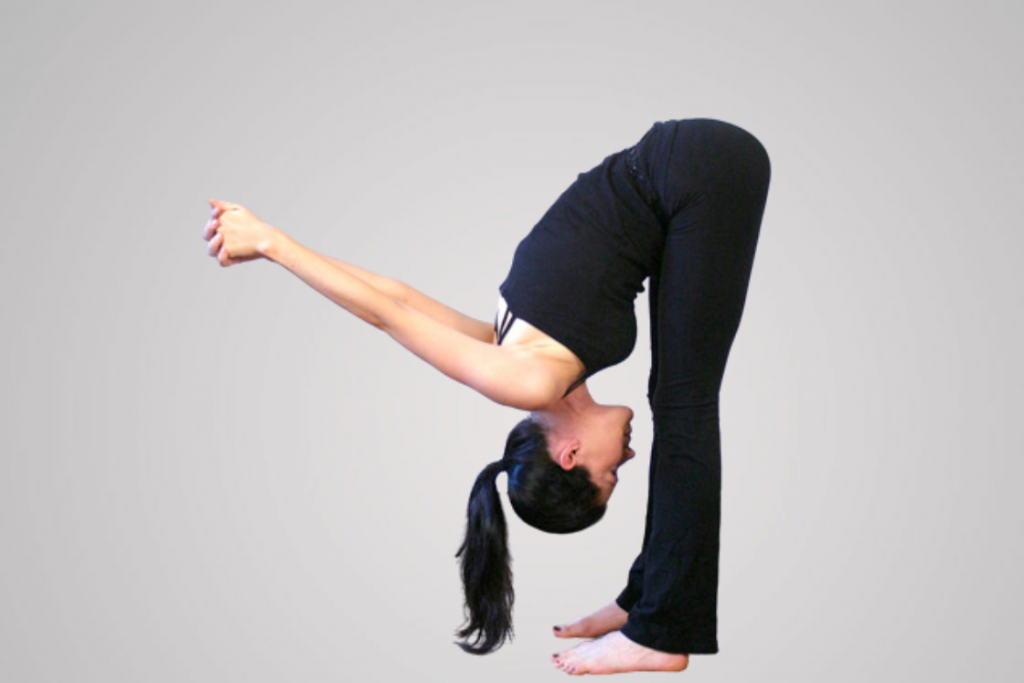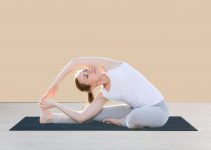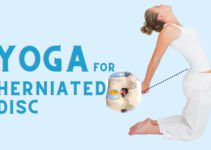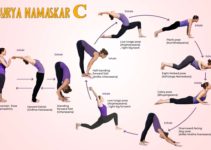
Dandayamana Yoga Mudrasana is a beginner pose performed in standing mountain pose by lifting the interlocked hands from behind and tilting your head down. This pose intrinsically stretches the shoulders, quadriceps, hamstrings, upper back, and lower traps.
In Dandayamana Yoga Mudrasana, ‘Danda’ means ‘Stick or Staff’, ‘Yamana’ means ‘balancing’ or ‘maintaining’, ‘Mudra’ means ‘seal’, and ‘asana’ means ‘pose’. Thus it translates as Standing Yoga Seal Pose. It’s called so because in this pose the hands are interlocked (or seated) back and one needs to balance the body in forward bend.
Dandayamana Yoga Mudrasana also known as Dwikonasana. Here, ‘Dwi’ means ‘Two’, ‘Kon’ means ‘Angle’, and ‘asana’ means ‘pose’. In the pose, the upper body makes one angle with the raised arms from behind and another angle with the lower body.
This pose is generally performed in the middle of standing sequence when core muscles are warmed up. It’s good for desk job persons as it provides flexibility and helps to strengthen the neck area, spine, hip joints, shoulder joints and arms. Moreover, it helps to regulate blood flow in your arteries that consequently helps to harmonize heart and soul.
Practice Guide of Dandayamana Yoga Mudrasana
To practice Dandayamana Yoga Mudrasana, follow the guide below-
Preparatory Poses
- Tadasana (Mountain Pose)
- Gomukhasana (Cow Face Pose)
- Adho Mukha Svanasana (Downward Facing Dog Pose)
- Yoga Mudrasana (Yoga Symbol Pose)
- Supta Vajrasana (Reclined Thunderbolt Pose)
Step-by-step instructions
- To start with, come into Tadasana, stand straight. The weight of your body should be equally divided between the soles of your feet and your palms should touch your outer thighs inwards.
- Now, open your feet 2-3 feet wide. Take your arms back and interlock the fingers. In this position, you have to make sure that your shoulder blades pull each other and your chest is straight and raised.
- With an exhale, slowly bring your interlaced hands upwards, and let your head hang comfortably from the neck forward. Bring your head as close to your knees as possible.
- In this position, your upper body will be making an angle with your arms upwards and downwards towards your lower body. That is why Dandayamana Yoga Mudrasana is also called Dwikonasana because two angles are formed in this position.
This will be your final position. Try to maintain this position for at least 10-12 breaths or as long as you feel comfortable.
After that, while leaving the pose, take a deep breath in and squeeze the shoulder blades and release your arms while exhaling.
Now, raise your upper body to a standing position, and bring the arms back to the sides of your body. Now once again stand in the position of Tadasana.
Contraindications
- If you are suffering from a recent or chronic injury of the neck, back, shoulders, or legs, you should not do Dandayamana Yoga Mudrasana.
- Unmedicated high blood pressure persons should avoid doing the pose.
- Also, pregnant women should restrain from doing the pose.
Precautions
- Before beginning the pose, you should perform preparatory asanas so that hamstrings and shoulder muscles loosen up.
- While starting the asana, stable and control your shoulder blades relative to your ribs. Keep in mind that by doing this you give a stable foundation to your muscles so that you can easily stretch the arms.
- Do not try to do this asana too quickly. This can put pressure on your neck. Make sure to enter this asana slowly so that you can do it smoothly and take advantage of it.
- Breathing is a very important role in yoga. So, try to coordinate the breathing with the movements of this asana.
Follow Up Poses
- Chakrasana (Wheel Pose)
- Ustrasana (Camel Pose)
Modifications, Props, and Variations
Although Dandayamana Yoga Mudrasana is a basic asana, it has the potential to make it easier for beginners and a little more difficult for advanced yoga practitioners.
Meanwhile, you can use props and also find some variations in the pose.
Modifications
- Try to keep your feet apart to make the pose easier and keep your feet closer together to make the pose more difficult.
- Similarly, when you get used to the asana and start feeling comfortable while doing it, then you can try to straighten your legs and arms more to increase the stretch.
- While doing this asana, advanced yoga practitioners can tilt their heads towards their feet or try to keep their heads between their knees.
Use of yoga strap
Alternatively, you can use a yoga strap to hold between your hands while practising Dandayamana Yoga Mudrasana. The yoga strap is attached between the hands and then along the back. With this, the hands can be easily brought up from behind.
Variations
- Uttrasana and Urdhva Uttrasana- You can bring variation in the pose by trying to touch your hands with your feet or with the ground.
- Utkatasana Vinyasa-You can bend your knees a little bit and can stretch your hands upwards by standing in a straight position.
- Parivrtta Utrasana– Leaning forward, try to take one hand on the ground and the other hand upwards.
Benefits of Dandayamana Yoga Mudrasana
1. Increases the flexibility of the shoulders and strengthen the arms
As you bring the arms interlocked from back to upwards, the blades of your shoulders, which we call scapulae in medical terms, come together. This stretches your shoulders and increases flexibility. This prevents injuries and eliminates muscle deficits in the shoulders.
Moreover, It helps to improve and maintain your body posture. It increases power in overhead throwing and lifting motions.
2. Improves the flexibility of the wrist joints and finger joints
Danyamana Yoga Mudrasana helps to improve the flexibility and dexterity of the wrist joints and finger joints. This is a stretching pose that works as a preventive measure to ease slight pain in the hands and fingers. It helps to strengthen your hands and fingers and also increases the range of their motion.
3. Helps to improve balance and stability
The pose trains the muscles in your pelvis, lower back, hips, and abdomen to work in harmony. This leads to better balance and stability to perform other physical activities.
4. Strengthens joints of hips and spine
Dandayamana Yoga Mudrasana helps to tone and strengthen joints of the hips and spine. It stretches the spine and hip joints while bending towards the knees during the pose.
Persons who keep working on the computer for a long time, it works like a wonder for them because it provides the hips and spine joints good stretch and flexibility.
Moreover, it promotes the blood flow in the lower muscles that consequently helps in back pain and sciatica.
5. Harmonizes the heart and mind
While performing the pose, your upper body comes towards your knees. This increases the blood supply to your head. It helps to reduce stress and anxiety. The pose acts as a harmony between the heart and the mind.
6. Helps to open the heart chakra
It is a pose where your shoulder blades act together, your chest widens. It will give you physical and mental energy that will consequently help you feel open and proud. It increases the flow of energy to the fourth chakra i.e. Heart Chakra that is associated with openness, confidence, and the ability to mingle with other persons.
7. Helps to tone the body
Dandyamana Yoga Mudrasan is a good asana to reduce belly fat, which makes your body toned. This works to slowly exhaust the abdominal fat. That’s why it plays a role in achieving your fitness goal.
Other Important benefits
- Dandayamana Yoga Mudrasana keeps your digestive system strong as it provides stretching to the stomach region.
- It helps to enlarge the size of breasts.
- The pose works to wake up your body parts and bring them to the active position.
Bottom Line
If you regularly practice Dandayamana Yoga Mudrasana with other asanas, you will be highly benefited. The pose works to utilize the upper body and lower body simultaneously. In addition, it helps to treat spine-related problems, shoulder pain, back pain, etc.
The pose not only helps to reduce physical pain in your body. but also relieves forms of inner pain that are stress and anxiety. So, you will observe the positive changes in your body and mind once you start practicing it.




